Literature Review: Impact of After School Programs on K-12 Education
VerifiedAdded on 2023/04/21
|47
|15112
|293
Literature Review
AI Summary
This literature review examines the impact of after-school programs on K-12 education, focusing on academic achievement, behavior, and attendance. It begins with an introduction emphasizing the importance of education and the concept of inclusive education, highlighting factors affecting student performance such as absenteeism and economic conditions. The review then explores after-school programs as a means of providing quality education, including mentoring, coaching, arts, and sports. The methodology section details the documentation process, search terms, databases, and inclusion/exclusion criteria used. The paper then provides a historical timeline of after-school programs, tracing developments from the late 1800s to the early 2000s, including key legislation and societal changes that influenced their growth. The review covers the growth of afterschool programs, goals, benefits, characteristics, types, views, funding, and theoretical framework. The review highlights the evolution of after-school programs, including the Comprehensive Child Development Act of 1971, the Child Care Development and Block Grant (CCDBG) of 1990, and the 21st Century Community Learning Centers (21CCLC) of 1998, and California’s Proposition 49 of 2002, emphasizing the importance of community involvement and funding in the success of these programs. The study concludes that these programs play a crucial role in addressing juvenile crime and supporting working parents.
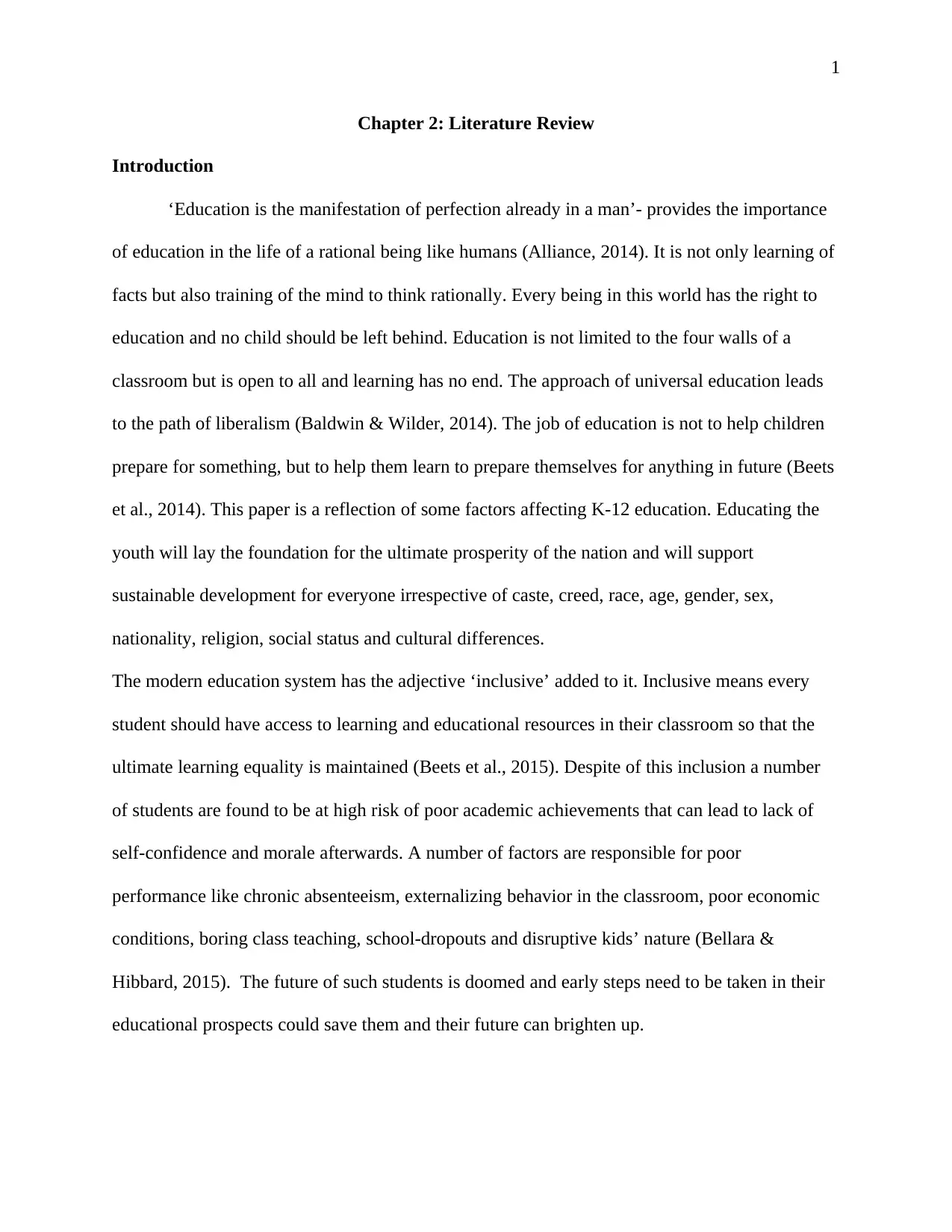
1
Chapter 2: Literature Review
Introduction
‘Education is the manifestation of perfection already in a man’- provides the importance
of education in the life of a rational being like humans (Alliance, 2014). It is not only learning of
facts but also training of the mind to think rationally. Every being in this world has the right to
education and no child should be left behind. Education is not limited to the four walls of a
classroom but is open to all and learning has no end. The approach of universal education leads
to the path of liberalism (Baldwin & Wilder, 2014). The job of education is not to help children
prepare for something, but to help them learn to prepare themselves for anything in future (Beets
et al., 2014). This paper is a reflection of some factors affecting K-12 education. Educating the
youth will lay the foundation for the ultimate prosperity of the nation and will support
sustainable development for everyone irrespective of caste, creed, race, age, gender, sex,
nationality, religion, social status and cultural differences.
The modern education system has the adjective ‘inclusive’ added to it. Inclusive means every
student should have access to learning and educational resources in their classroom so that the
ultimate learning equality is maintained (Beets et al., 2015). Despite of this inclusion a number
of students are found to be at high risk of poor academic achievements that can lead to lack of
self-confidence and morale afterwards. A number of factors are responsible for poor
performance like chronic absenteeism, externalizing behavior in the classroom, poor economic
conditions, boring class teaching, school-dropouts and disruptive kids’ nature (Bellara &
Hibbard, 2015). The future of such students is doomed and early steps need to be taken in their
educational prospects could save them and their future can brighten up.
Chapter 2: Literature Review
Introduction
‘Education is the manifestation of perfection already in a man’- provides the importance
of education in the life of a rational being like humans (Alliance, 2014). It is not only learning of
facts but also training of the mind to think rationally. Every being in this world has the right to
education and no child should be left behind. Education is not limited to the four walls of a
classroom but is open to all and learning has no end. The approach of universal education leads
to the path of liberalism (Baldwin & Wilder, 2014). The job of education is not to help children
prepare for something, but to help them learn to prepare themselves for anything in future (Beets
et al., 2014). This paper is a reflection of some factors affecting K-12 education. Educating the
youth will lay the foundation for the ultimate prosperity of the nation and will support
sustainable development for everyone irrespective of caste, creed, race, age, gender, sex,
nationality, religion, social status and cultural differences.
The modern education system has the adjective ‘inclusive’ added to it. Inclusive means every
student should have access to learning and educational resources in their classroom so that the
ultimate learning equality is maintained (Beets et al., 2015). Despite of this inclusion a number
of students are found to be at high risk of poor academic achievements that can lead to lack of
self-confidence and morale afterwards. A number of factors are responsible for poor
performance like chronic absenteeism, externalizing behavior in the classroom, poor economic
conditions, boring class teaching, school-dropouts and disruptive kids’ nature (Bellara &
Hibbard, 2015). The future of such students is doomed and early steps need to be taken in their
educational prospects could save them and their future can brighten up.
Paraphrase This Document
Need a fresh take? Get an instant paraphrase of this document with our AI Paraphraser
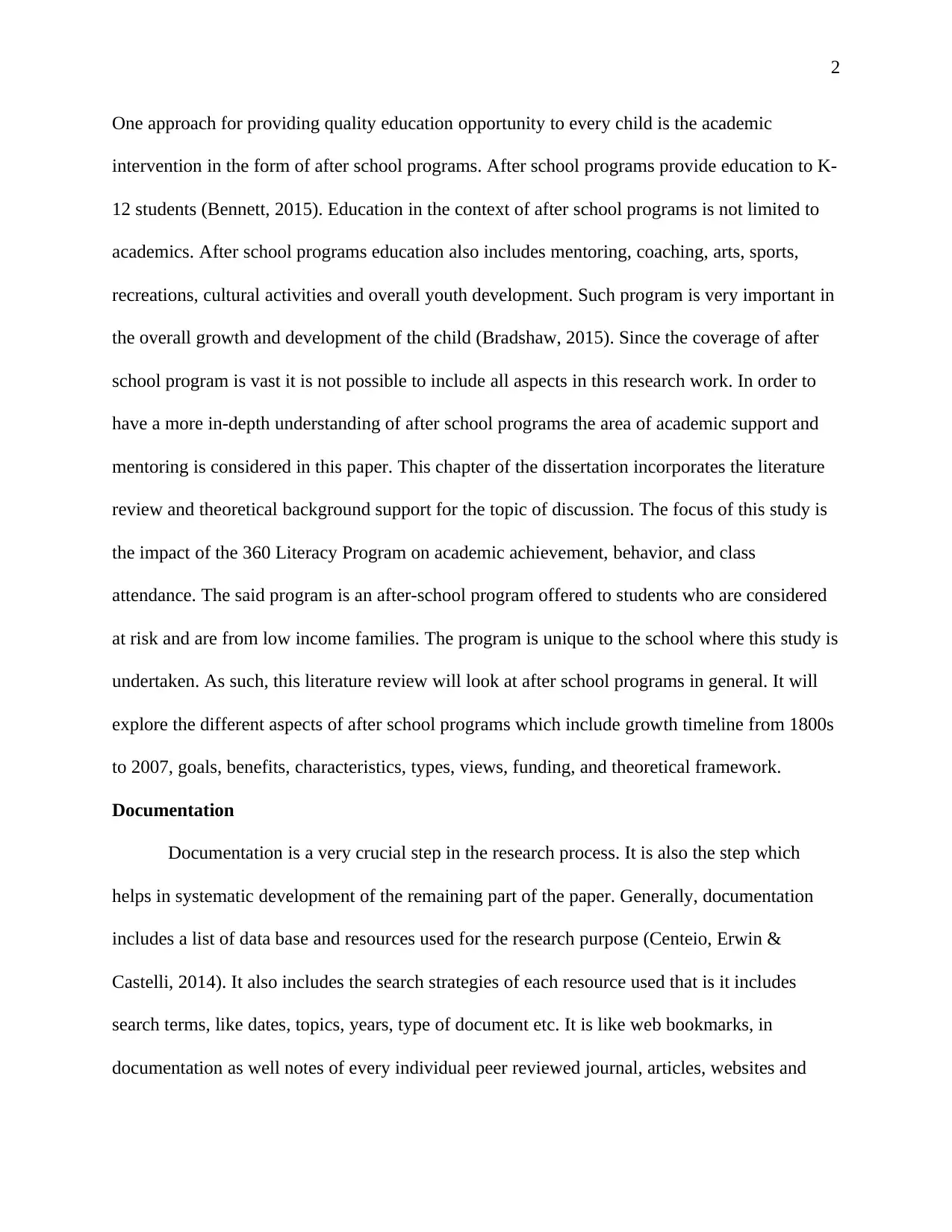
2
One approach for providing quality education opportunity to every child is the academic
intervention in the form of after school programs. After school programs provide education to K-
12 students (Bennett, 2015). Education in the context of after school programs is not limited to
academics. After school programs education also includes mentoring, coaching, arts, sports,
recreations, cultural activities and overall youth development. Such program is very important in
the overall growth and development of the child (Bradshaw, 2015). Since the coverage of after
school program is vast it is not possible to include all aspects in this research work. In order to
have a more in-depth understanding of after school programs the area of academic support and
mentoring is considered in this paper. This chapter of the dissertation incorporates the literature
review and theoretical background support for the topic of discussion. The focus of this study is
the impact of the 360 Literacy Program on academic achievement, behavior, and class
attendance. The said program is an after-school program offered to students who are considered
at risk and are from low income families. The program is unique to the school where this study is
undertaken. As such, this literature review will look at after school programs in general. It will
explore the different aspects of after school programs which include growth timeline from 1800s
to 2007, goals, benefits, characteristics, types, views, funding, and theoretical framework.
Documentation
Documentation is a very crucial step in the research process. It is also the step which
helps in systematic development of the remaining part of the paper. Generally, documentation
includes a list of data base and resources used for the research purpose (Centeio, Erwin &
Castelli, 2014). It also includes the search strategies of each resource used that is it includes
search terms, like dates, topics, years, type of document etc. It is like web bookmarks, in
documentation as well notes of every individual peer reviewed journal, articles, websites and
One approach for providing quality education opportunity to every child is the academic
intervention in the form of after school programs. After school programs provide education to K-
12 students (Bennett, 2015). Education in the context of after school programs is not limited to
academics. After school programs education also includes mentoring, coaching, arts, sports,
recreations, cultural activities and overall youth development. Such program is very important in
the overall growth and development of the child (Bradshaw, 2015). Since the coverage of after
school program is vast it is not possible to include all aspects in this research work. In order to
have a more in-depth understanding of after school programs the area of academic support and
mentoring is considered in this paper. This chapter of the dissertation incorporates the literature
review and theoretical background support for the topic of discussion. The focus of this study is
the impact of the 360 Literacy Program on academic achievement, behavior, and class
attendance. The said program is an after-school program offered to students who are considered
at risk and are from low income families. The program is unique to the school where this study is
undertaken. As such, this literature review will look at after school programs in general. It will
explore the different aspects of after school programs which include growth timeline from 1800s
to 2007, goals, benefits, characteristics, types, views, funding, and theoretical framework.
Documentation
Documentation is a very crucial step in the research process. It is also the step which
helps in systematic development of the remaining part of the paper. Generally, documentation
includes a list of data base and resources used for the research purpose (Centeio, Erwin &
Castelli, 2014). It also includes the search strategies of each resource used that is it includes
search terms, like dates, topics, years, type of document etc. It is like web bookmarks, in
documentation as well notes of every individual peer reviewed journal, articles, websites and
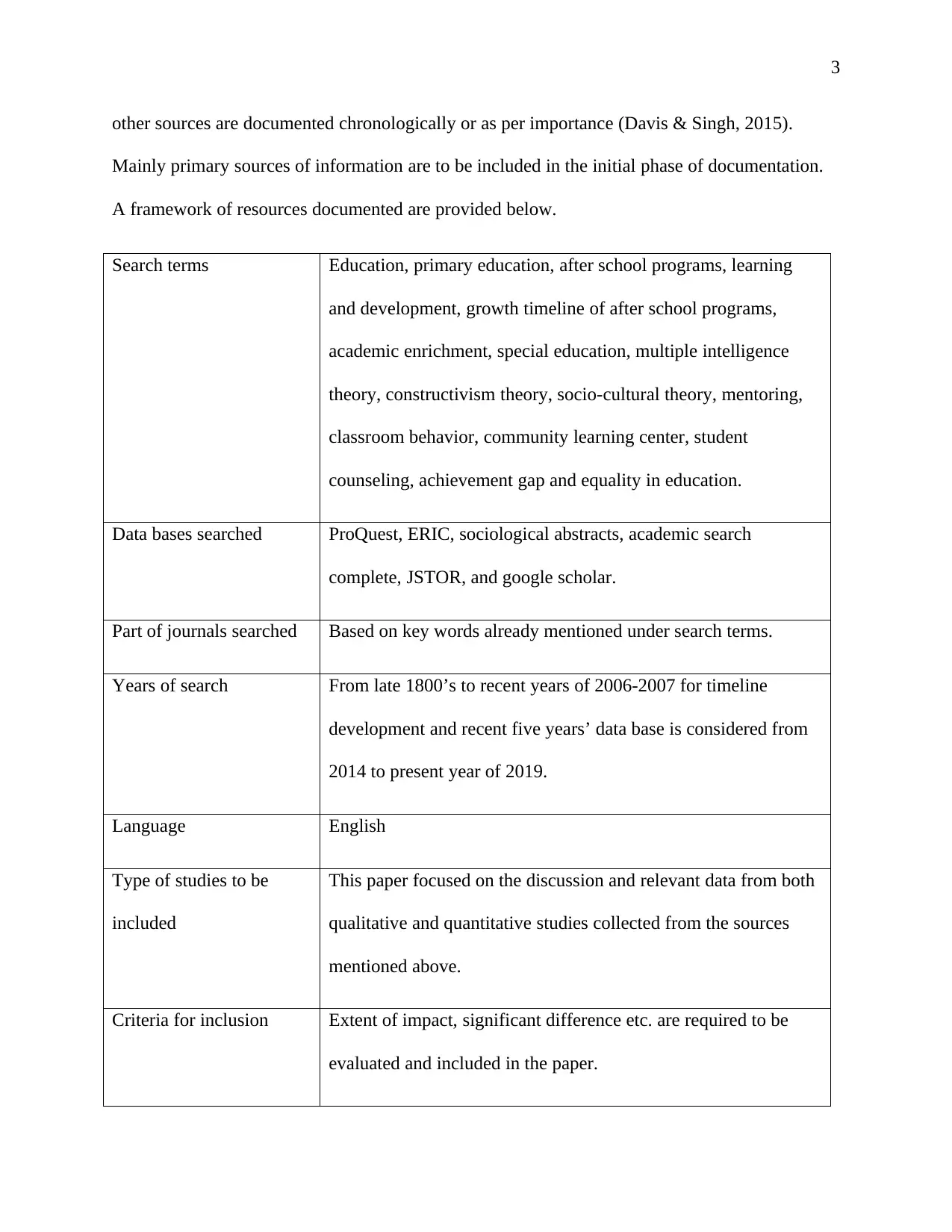
3
other sources are documented chronologically or as per importance (Davis & Singh, 2015).
Mainly primary sources of information are to be included in the initial phase of documentation.
A framework of resources documented are provided below.
Search terms Education, primary education, after school programs, learning
and development, growth timeline of after school programs,
academic enrichment, special education, multiple intelligence
theory, constructivism theory, socio-cultural theory, mentoring,
classroom behavior, community learning center, student
counseling, achievement gap and equality in education.
Data bases searched ProQuest, ERIC, sociological abstracts, academic search
complete, JSTOR, and google scholar.
Part of journals searched Based on key words already mentioned under search terms.
Years of search From late 1800’s to recent years of 2006-2007 for timeline
development and recent five years’ data base is considered from
2014 to present year of 2019.
Language English
Type of studies to be
included
This paper focused on the discussion and relevant data from both
qualitative and quantitative studies collected from the sources
mentioned above.
Criteria for inclusion Extent of impact, significant difference etc. are required to be
evaluated and included in the paper.
other sources are documented chronologically or as per importance (Davis & Singh, 2015).
Mainly primary sources of information are to be included in the initial phase of documentation.
A framework of resources documented are provided below.
Search terms Education, primary education, after school programs, learning
and development, growth timeline of after school programs,
academic enrichment, special education, multiple intelligence
theory, constructivism theory, socio-cultural theory, mentoring,
classroom behavior, community learning center, student
counseling, achievement gap and equality in education.
Data bases searched ProQuest, ERIC, sociological abstracts, academic search
complete, JSTOR, and google scholar.
Part of journals searched Based on key words already mentioned under search terms.
Years of search From late 1800’s to recent years of 2006-2007 for timeline
development and recent five years’ data base is considered from
2014 to present year of 2019.
Language English
Type of studies to be
included
This paper focused on the discussion and relevant data from both
qualitative and quantitative studies collected from the sources
mentioned above.
Criteria for inclusion Extent of impact, significant difference etc. are required to be
evaluated and included in the paper.
⊘ This is a preview!⊘
Do you want full access?
Subscribe today to unlock all pages.

Trusted by 1+ million students worldwide
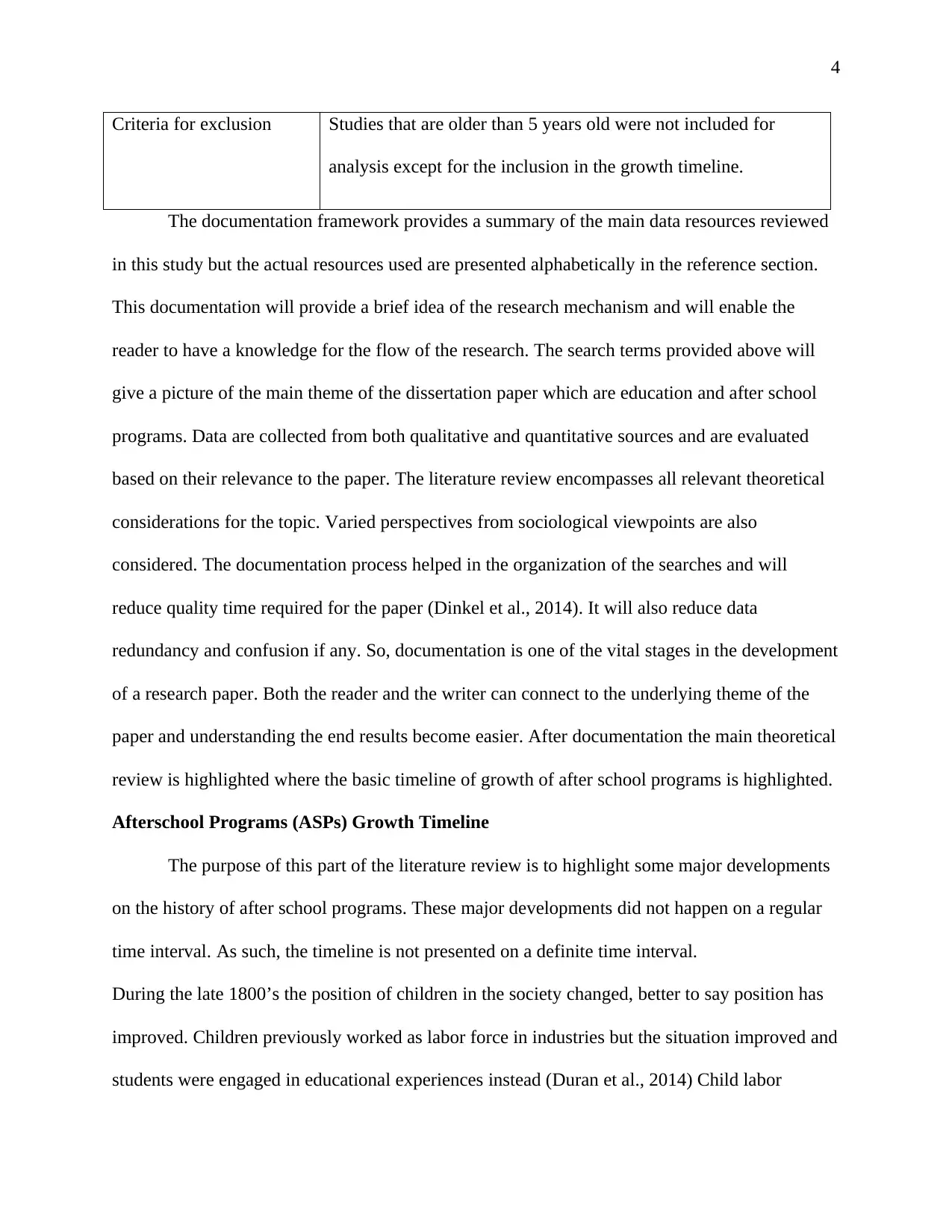
4
Criteria for exclusion Studies that are older than 5 years old were not included for
analysis except for the inclusion in the growth timeline.
The documentation framework provides a summary of the main data resources reviewed
in this study but the actual resources used are presented alphabetically in the reference section.
This documentation will provide a brief idea of the research mechanism and will enable the
reader to have a knowledge for the flow of the research. The search terms provided above will
give a picture of the main theme of the dissertation paper which are education and after school
programs. Data are collected from both qualitative and quantitative sources and are evaluated
based on their relevance to the paper. The literature review encompasses all relevant theoretical
considerations for the topic. Varied perspectives from sociological viewpoints are also
considered. The documentation process helped in the organization of the searches and will
reduce quality time required for the paper (Dinkel et al., 2014). It will also reduce data
redundancy and confusion if any. So, documentation is one of the vital stages in the development
of a research paper. Both the reader and the writer can connect to the underlying theme of the
paper and understanding the end results become easier. After documentation the main theoretical
review is highlighted where the basic timeline of growth of after school programs is highlighted.
Afterschool Programs (ASPs) Growth Timeline
The purpose of this part of the literature review is to highlight some major developments
on the history of after school programs. These major developments did not happen on a regular
time interval. As such, the timeline is not presented on a definite time interval.
During the late 1800’s the position of children in the society changed, better to say position has
improved. Children previously worked as labor force in industries but the situation improved and
students were engaged in educational experiences instead (Duran et al., 2014) Child labor
Criteria for exclusion Studies that are older than 5 years old were not included for
analysis except for the inclusion in the growth timeline.
The documentation framework provides a summary of the main data resources reviewed
in this study but the actual resources used are presented alphabetically in the reference section.
This documentation will provide a brief idea of the research mechanism and will enable the
reader to have a knowledge for the flow of the research. The search terms provided above will
give a picture of the main theme of the dissertation paper which are education and after school
programs. Data are collected from both qualitative and quantitative sources and are evaluated
based on their relevance to the paper. The literature review encompasses all relevant theoretical
considerations for the topic. Varied perspectives from sociological viewpoints are also
considered. The documentation process helped in the organization of the searches and will
reduce quality time required for the paper (Dinkel et al., 2014). It will also reduce data
redundancy and confusion if any. So, documentation is one of the vital stages in the development
of a research paper. Both the reader and the writer can connect to the underlying theme of the
paper and understanding the end results become easier. After documentation the main theoretical
review is highlighted where the basic timeline of growth of after school programs is highlighted.
Afterschool Programs (ASPs) Growth Timeline
The purpose of this part of the literature review is to highlight some major developments
on the history of after school programs. These major developments did not happen on a regular
time interval. As such, the timeline is not presented on a definite time interval.
During the late 1800’s the position of children in the society changed, better to say position has
improved. Children previously worked as labor force in industries but the situation improved and
students were engaged in educational experiences instead (Duran et al., 2014) Child labor
Paraphrase This Document
Need a fresh take? Get an instant paraphrase of this document with our AI Paraphraser
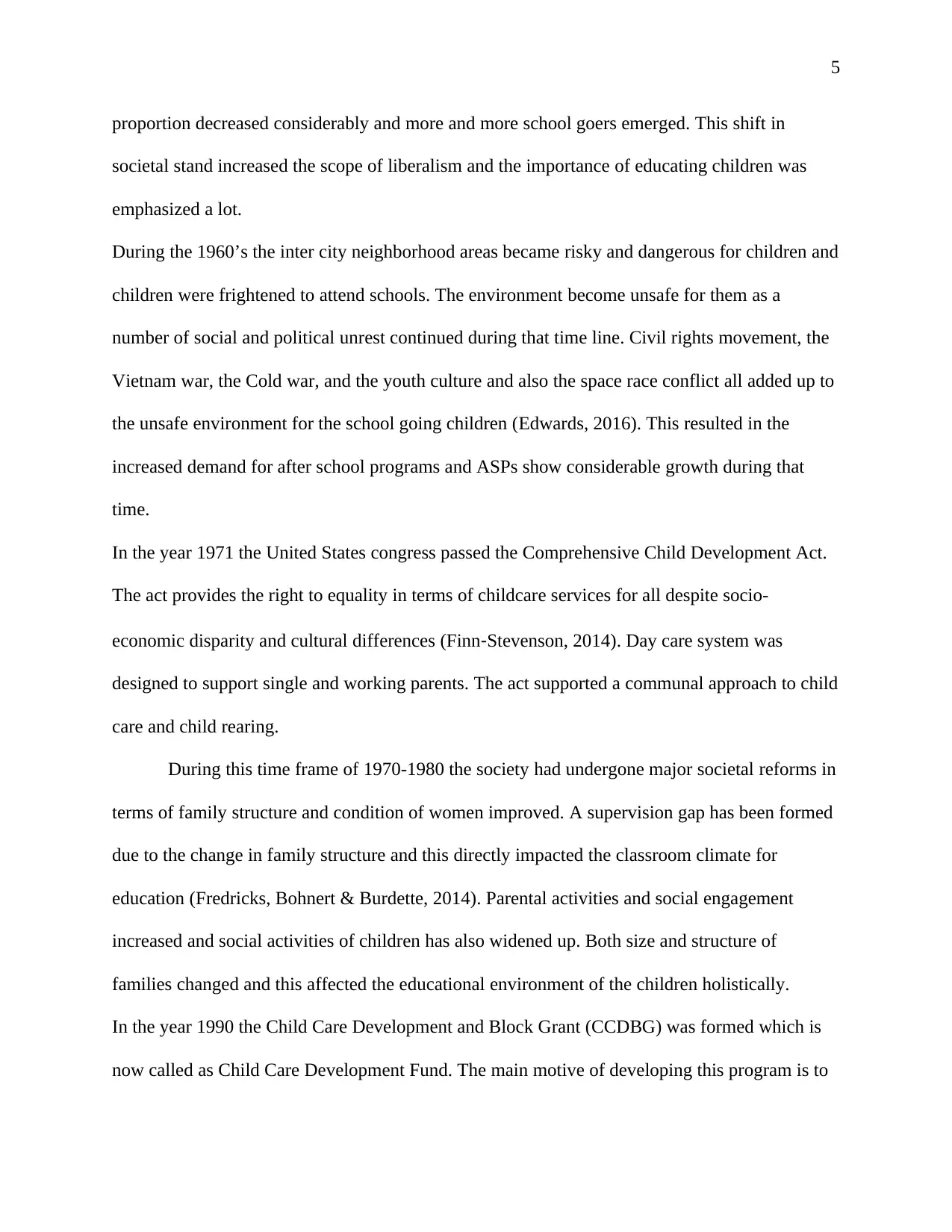
5
proportion decreased considerably and more and more school goers emerged. This shift in
societal stand increased the scope of liberalism and the importance of educating children was
emphasized a lot.
During the 1960’s the inter city neighborhood areas became risky and dangerous for children and
children were frightened to attend schools. The environment become unsafe for them as a
number of social and political unrest continued during that time line. Civil rights movement, the
Vietnam war, the Cold war, and the youth culture and also the space race conflict all added up to
the unsafe environment for the school going children (Edwards, 2016). This resulted in the
increased demand for after school programs and ASPs show considerable growth during that
time.
In the year 1971 the United States congress passed the Comprehensive Child Development Act.
The act provides the right to equality in terms of childcare services for all despite socio-
economic disparity and cultural differences (Finn‐Stevenson, 2014). Day care system was
designed to support single and working parents. The act supported a communal approach to child
care and child rearing.
During this time frame of 1970-1980 the society had undergone major societal reforms in
terms of family structure and condition of women improved. A supervision gap has been formed
due to the change in family structure and this directly impacted the classroom climate for
education (Fredricks, Bohnert & Burdette, 2014). Parental activities and social engagement
increased and social activities of children has also widened up. Both size and structure of
families changed and this affected the educational environment of the children holistically.
In the year 1990 the Child Care Development and Block Grant (CCDBG) was formed which is
now called as Child Care Development Fund. The main motive of developing this program is to
proportion decreased considerably and more and more school goers emerged. This shift in
societal stand increased the scope of liberalism and the importance of educating children was
emphasized a lot.
During the 1960’s the inter city neighborhood areas became risky and dangerous for children and
children were frightened to attend schools. The environment become unsafe for them as a
number of social and political unrest continued during that time line. Civil rights movement, the
Vietnam war, the Cold war, and the youth culture and also the space race conflict all added up to
the unsafe environment for the school going children (Edwards, 2016). This resulted in the
increased demand for after school programs and ASPs show considerable growth during that
time.
In the year 1971 the United States congress passed the Comprehensive Child Development Act.
The act provides the right to equality in terms of childcare services for all despite socio-
economic disparity and cultural differences (Finn‐Stevenson, 2014). Day care system was
designed to support single and working parents. The act supported a communal approach to child
care and child rearing.
During this time frame of 1970-1980 the society had undergone major societal reforms in
terms of family structure and condition of women improved. A supervision gap has been formed
due to the change in family structure and this directly impacted the classroom climate for
education (Fredricks, Bohnert & Burdette, 2014). Parental activities and social engagement
increased and social activities of children has also widened up. Both size and structure of
families changed and this affected the educational environment of the children holistically.
In the year 1990 the Child Care Development and Block Grant (CCDBG) was formed which is
now called as Child Care Development Fund. The main motive of developing this program is to
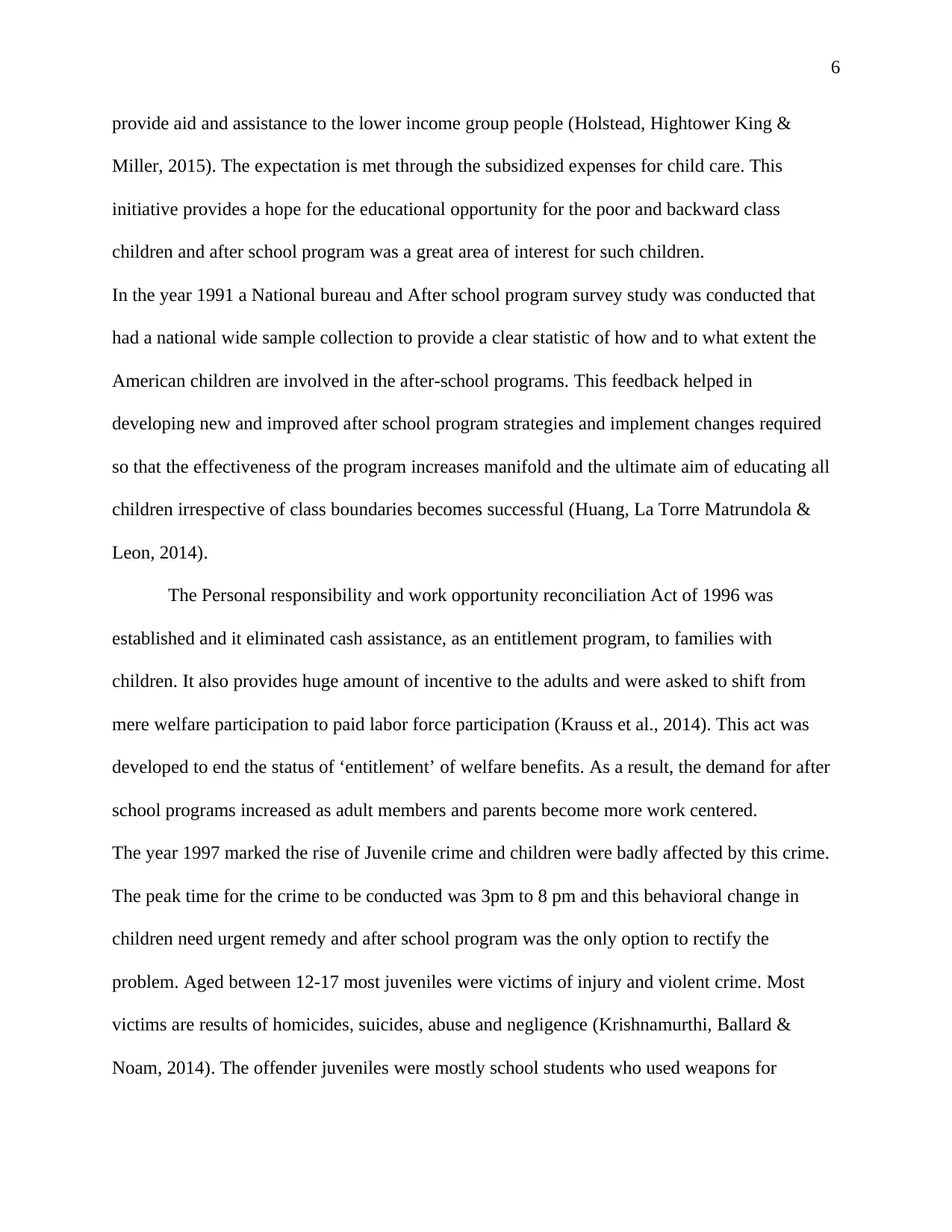
6
provide aid and assistance to the lower income group people (Holstead, Hightower King &
Miller, 2015). The expectation is met through the subsidized expenses for child care. This
initiative provides a hope for the educational opportunity for the poor and backward class
children and after school program was a great area of interest for such children.
In the year 1991 a National bureau and After school program survey study was conducted that
had a national wide sample collection to provide a clear statistic of how and to what extent the
American children are involved in the after-school programs. This feedback helped in
developing new and improved after school program strategies and implement changes required
so that the effectiveness of the program increases manifold and the ultimate aim of educating all
children irrespective of class boundaries becomes successful (Huang, La Torre Matrundola &
Leon, 2014).
The Personal responsibility and work opportunity reconciliation Act of 1996 was
established and it eliminated cash assistance, as an entitlement program, to families with
children. It also provides huge amount of incentive to the adults and were asked to shift from
mere welfare participation to paid labor force participation (Krauss et al., 2014). This act was
developed to end the status of ‘entitlement’ of welfare benefits. As a result, the demand for after
school programs increased as adult members and parents become more work centered.
The year 1997 marked the rise of Juvenile crime and children were badly affected by this crime.
The peak time for the crime to be conducted was 3pm to 8 pm and this behavioral change in
children need urgent remedy and after school program was the only option to rectify the
problem. Aged between 12-17 most juveniles were victims of injury and violent crime. Most
victims are results of homicides, suicides, abuse and negligence (Krishnamurthi, Ballard &
Noam, 2014). The offender juveniles were mostly school students who used weapons for
provide aid and assistance to the lower income group people (Holstead, Hightower King &
Miller, 2015). The expectation is met through the subsidized expenses for child care. This
initiative provides a hope for the educational opportunity for the poor and backward class
children and after school program was a great area of interest for such children.
In the year 1991 a National bureau and After school program survey study was conducted that
had a national wide sample collection to provide a clear statistic of how and to what extent the
American children are involved in the after-school programs. This feedback helped in
developing new and improved after school program strategies and implement changes required
so that the effectiveness of the program increases manifold and the ultimate aim of educating all
children irrespective of class boundaries becomes successful (Huang, La Torre Matrundola &
Leon, 2014).
The Personal responsibility and work opportunity reconciliation Act of 1996 was
established and it eliminated cash assistance, as an entitlement program, to families with
children. It also provides huge amount of incentive to the adults and were asked to shift from
mere welfare participation to paid labor force participation (Krauss et al., 2014). This act was
developed to end the status of ‘entitlement’ of welfare benefits. As a result, the demand for after
school programs increased as adult members and parents become more work centered.
The year 1997 marked the rise of Juvenile crime and children were badly affected by this crime.
The peak time for the crime to be conducted was 3pm to 8 pm and this behavioral change in
children need urgent remedy and after school program was the only option to rectify the
problem. Aged between 12-17 most juveniles were victims of injury and violent crime. Most
victims are results of homicides, suicides, abuse and negligence (Krishnamurthi, Ballard &
Noam, 2014). The offender juveniles were mostly school students who used weapons for
⊘ This is a preview!⊘
Do you want full access?
Subscribe today to unlock all pages.

Trusted by 1+ million students worldwide
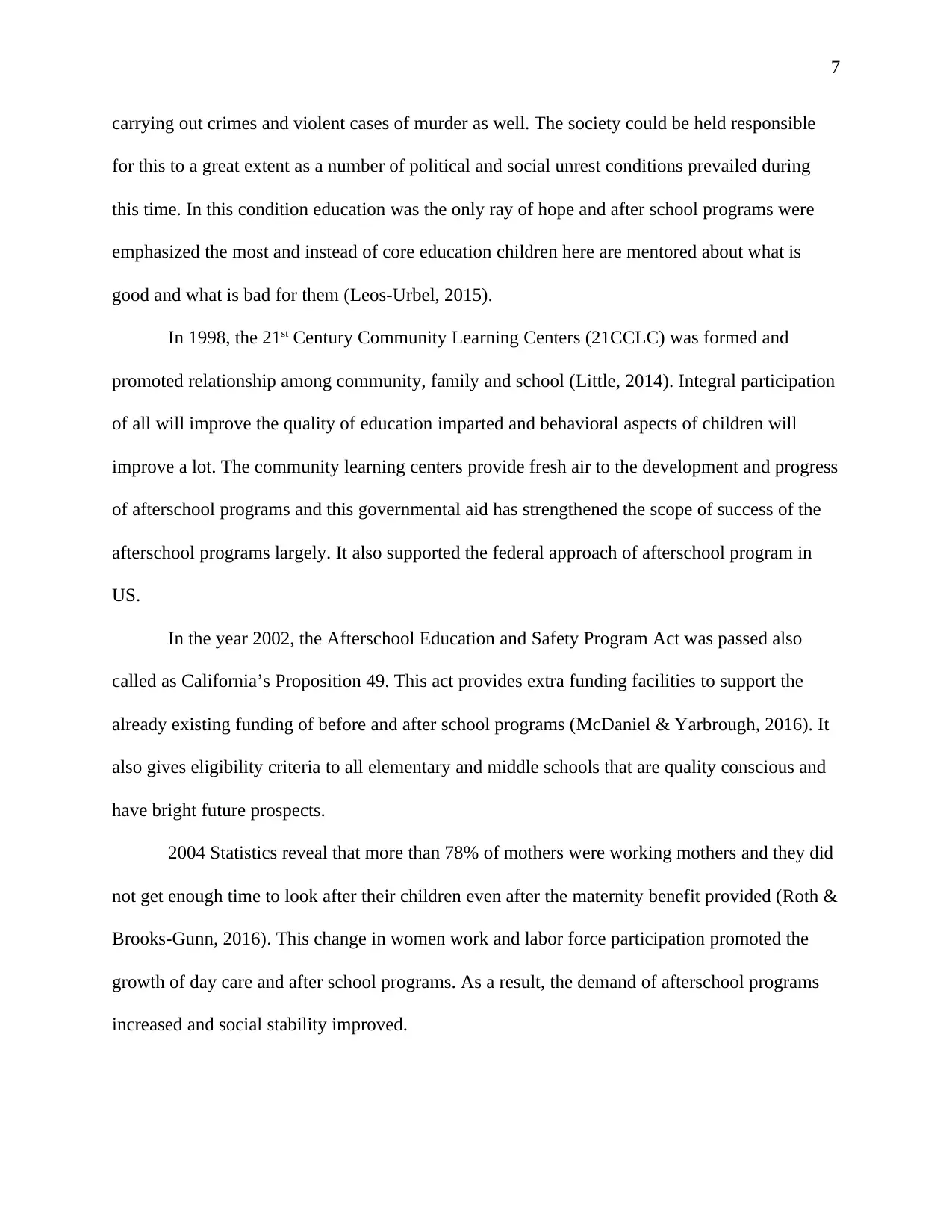
7
carrying out crimes and violent cases of murder as well. The society could be held responsible
for this to a great extent as a number of political and social unrest conditions prevailed during
this time. In this condition education was the only ray of hope and after school programs were
emphasized the most and instead of core education children here are mentored about what is
good and what is bad for them (Leos-Urbel, 2015).
In 1998, the 21st Century Community Learning Centers (21CCLC) was formed and
promoted relationship among community, family and school (Little, 2014). Integral participation
of all will improve the quality of education imparted and behavioral aspects of children will
improve a lot. The community learning centers provide fresh air to the development and progress
of afterschool programs and this governmental aid has strengthened the scope of success of the
afterschool programs largely. It also supported the federal approach of afterschool program in
US.
In the year 2002, the Afterschool Education and Safety Program Act was passed also
called as California’s Proposition 49. This act provides extra funding facilities to support the
already existing funding of before and after school programs (McDaniel & Yarbrough, 2016). It
also gives eligibility criteria to all elementary and middle schools that are quality conscious and
have bright future prospects.
2004 Statistics reveal that more than 78% of mothers were working mothers and they did
not get enough time to look after their children even after the maternity benefit provided (Roth &
Brooks-Gunn, 2016). This change in women work and labor force participation promoted the
growth of day care and after school programs. As a result, the demand of afterschool programs
increased and social stability improved.
carrying out crimes and violent cases of murder as well. The society could be held responsible
for this to a great extent as a number of political and social unrest conditions prevailed during
this time. In this condition education was the only ray of hope and after school programs were
emphasized the most and instead of core education children here are mentored about what is
good and what is bad for them (Leos-Urbel, 2015).
In 1998, the 21st Century Community Learning Centers (21CCLC) was formed and
promoted relationship among community, family and school (Little, 2014). Integral participation
of all will improve the quality of education imparted and behavioral aspects of children will
improve a lot. The community learning centers provide fresh air to the development and progress
of afterschool programs and this governmental aid has strengthened the scope of success of the
afterschool programs largely. It also supported the federal approach of afterschool program in
US.
In the year 2002, the Afterschool Education and Safety Program Act was passed also
called as California’s Proposition 49. This act provides extra funding facilities to support the
already existing funding of before and after school programs (McDaniel & Yarbrough, 2016). It
also gives eligibility criteria to all elementary and middle schools that are quality conscious and
have bright future prospects.
2004 Statistics reveal that more than 78% of mothers were working mothers and they did
not get enough time to look after their children even after the maternity benefit provided (Roth &
Brooks-Gunn, 2016). This change in women work and labor force participation promoted the
growth of day care and after school programs. As a result, the demand of afterschool programs
increased and social stability improved.
Paraphrase This Document
Need a fresh take? Get an instant paraphrase of this document with our AI Paraphraser
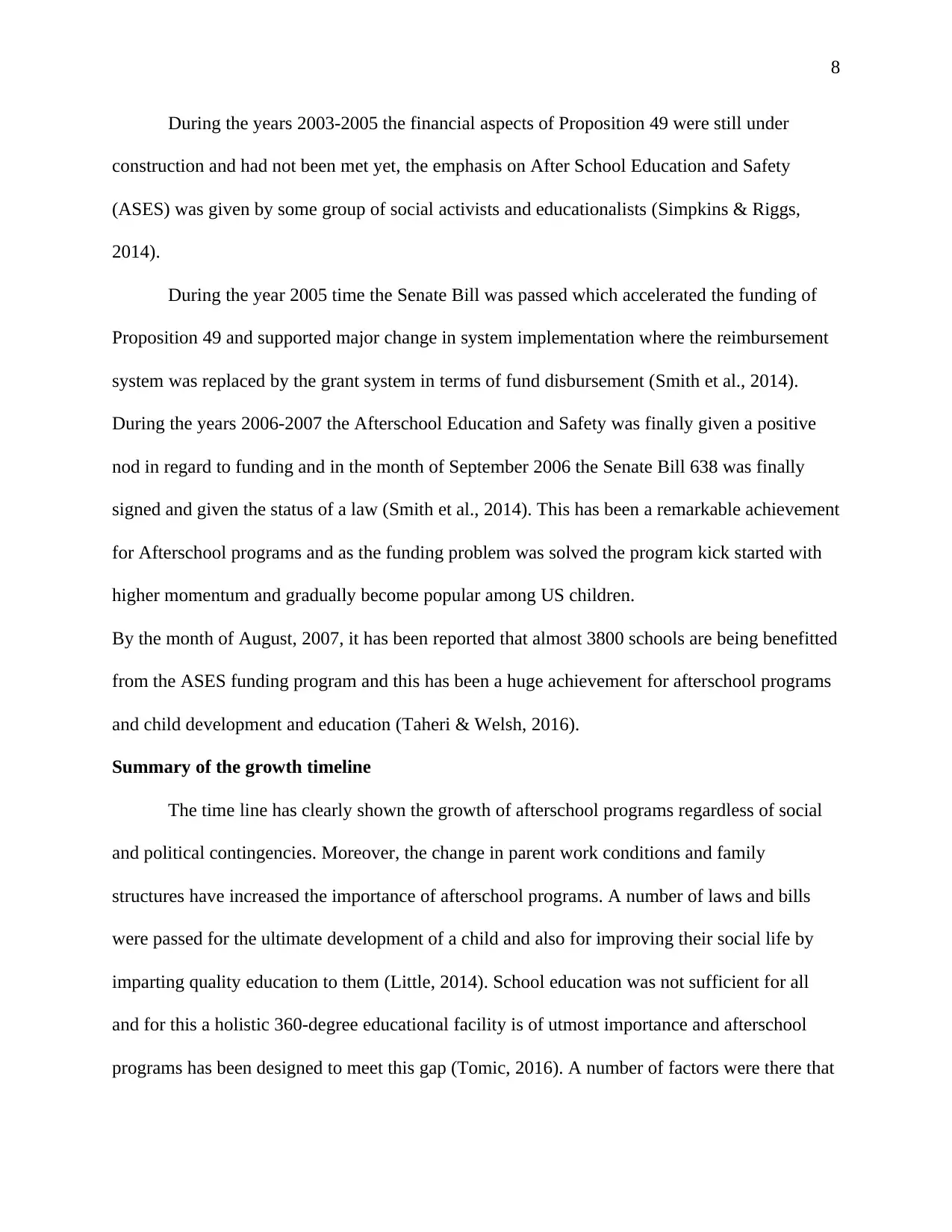
8
During the years 2003-2005 the financial aspects of Proposition 49 were still under
construction and had not been met yet, the emphasis on After School Education and Safety
(ASES) was given by some group of social activists and educationalists (Simpkins & Riggs,
2014).
During the year 2005 time the Senate Bill was passed which accelerated the funding of
Proposition 49 and supported major change in system implementation where the reimbursement
system was replaced by the grant system in terms of fund disbursement (Smith et al., 2014).
During the years 2006-2007 the Afterschool Education and Safety was finally given a positive
nod in regard to funding and in the month of September 2006 the Senate Bill 638 was finally
signed and given the status of a law (Smith et al., 2014). This has been a remarkable achievement
for Afterschool programs and as the funding problem was solved the program kick started with
higher momentum and gradually become popular among US children.
By the month of August, 2007, it has been reported that almost 3800 schools are being benefitted
from the ASES funding program and this has been a huge achievement for afterschool programs
and child development and education (Taheri & Welsh, 2016).
Summary of the growth timeline
The time line has clearly shown the growth of afterschool programs regardless of social
and political contingencies. Moreover, the change in parent work conditions and family
structures have increased the importance of afterschool programs. A number of laws and bills
were passed for the ultimate development of a child and also for improving their social life by
imparting quality education to them (Little, 2014). School education was not sufficient for all
and for this a holistic 360-degree educational facility is of utmost importance and afterschool
programs has been designed to meet this gap (Tomic, 2016). A number of factors were there that
During the years 2003-2005 the financial aspects of Proposition 49 were still under
construction and had not been met yet, the emphasis on After School Education and Safety
(ASES) was given by some group of social activists and educationalists (Simpkins & Riggs,
2014).
During the year 2005 time the Senate Bill was passed which accelerated the funding of
Proposition 49 and supported major change in system implementation where the reimbursement
system was replaced by the grant system in terms of fund disbursement (Smith et al., 2014).
During the years 2006-2007 the Afterschool Education and Safety was finally given a positive
nod in regard to funding and in the month of September 2006 the Senate Bill 638 was finally
signed and given the status of a law (Smith et al., 2014). This has been a remarkable achievement
for Afterschool programs and as the funding problem was solved the program kick started with
higher momentum and gradually become popular among US children.
By the month of August, 2007, it has been reported that almost 3800 schools are being benefitted
from the ASES funding program and this has been a huge achievement for afterschool programs
and child development and education (Taheri & Welsh, 2016).
Summary of the growth timeline
The time line has clearly shown the growth of afterschool programs regardless of social
and political contingencies. Moreover, the change in parent work conditions and family
structures have increased the importance of afterschool programs. A number of laws and bills
were passed for the ultimate development of a child and also for improving their social life by
imparting quality education to them (Little, 2014). School education was not sufficient for all
and for this a holistic 360-degree educational facility is of utmost importance and afterschool
programs has been designed to meet this gap (Tomic, 2016). A number of factors were there that
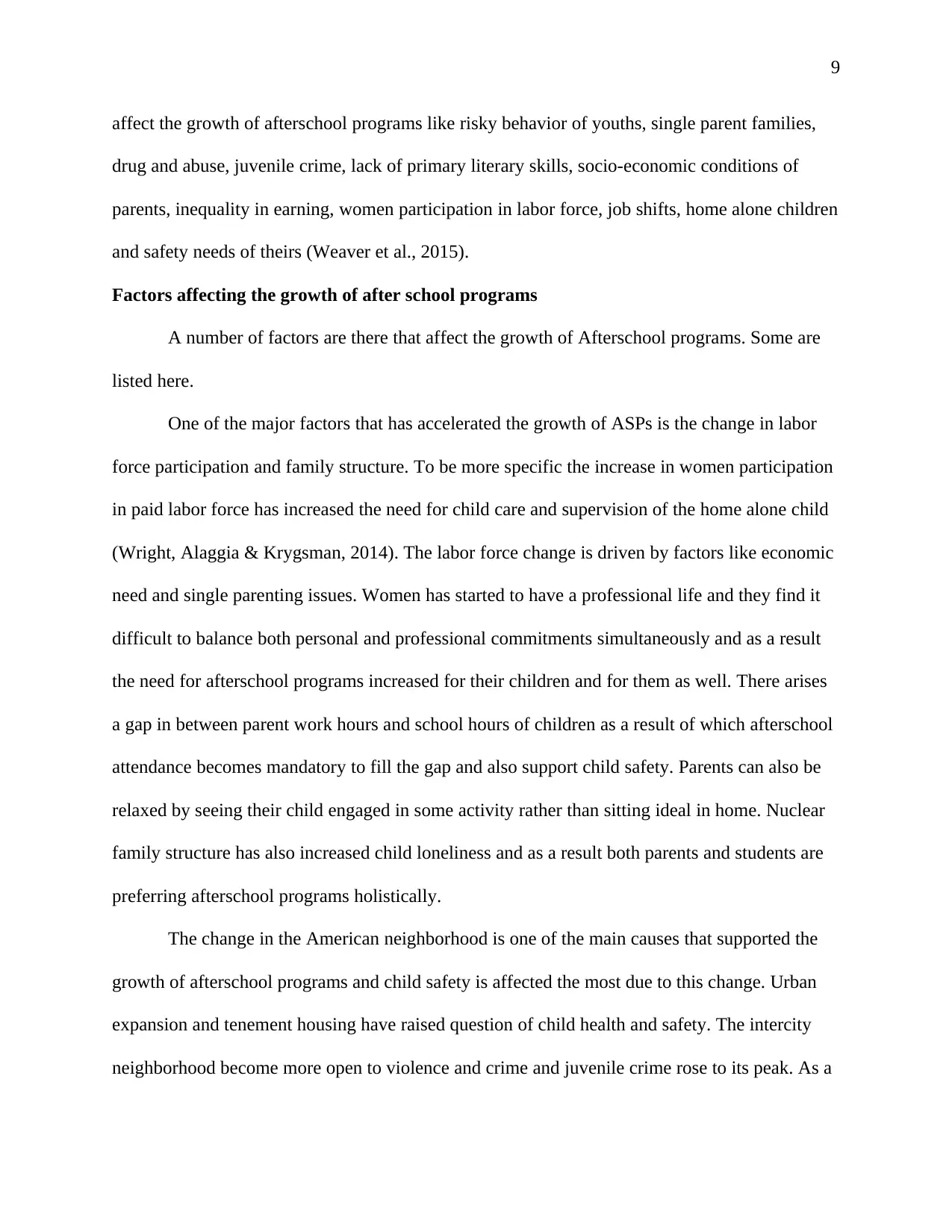
9
affect the growth of afterschool programs like risky behavior of youths, single parent families,
drug and abuse, juvenile crime, lack of primary literary skills, socio-economic conditions of
parents, inequality in earning, women participation in labor force, job shifts, home alone children
and safety needs of theirs (Weaver et al., 2015).
Factors affecting the growth of after school programs
A number of factors are there that affect the growth of Afterschool programs. Some are
listed here.
One of the major factors that has accelerated the growth of ASPs is the change in labor
force participation and family structure. To be more specific the increase in women participation
in paid labor force has increased the need for child care and supervision of the home alone child
(Wright, Alaggia & Krygsman, 2014). The labor force change is driven by factors like economic
need and single parenting issues. Women has started to have a professional life and they find it
difficult to balance both personal and professional commitments simultaneously and as a result
the need for afterschool programs increased for their children and for them as well. There arises
a gap in between parent work hours and school hours of children as a result of which afterschool
attendance becomes mandatory to fill the gap and also support child safety. Parents can also be
relaxed by seeing their child engaged in some activity rather than sitting ideal in home. Nuclear
family structure has also increased child loneliness and as a result both parents and students are
preferring afterschool programs holistically.
The change in the American neighborhood is one of the main causes that supported the
growth of afterschool programs and child safety is affected the most due to this change. Urban
expansion and tenement housing have raised question of child health and safety. The intercity
neighborhood become more open to violence and crime and juvenile crime rose to its peak. As a
affect the growth of afterschool programs like risky behavior of youths, single parent families,
drug and abuse, juvenile crime, lack of primary literary skills, socio-economic conditions of
parents, inequality in earning, women participation in labor force, job shifts, home alone children
and safety needs of theirs (Weaver et al., 2015).
Factors affecting the growth of after school programs
A number of factors are there that affect the growth of Afterschool programs. Some are
listed here.
One of the major factors that has accelerated the growth of ASPs is the change in labor
force participation and family structure. To be more specific the increase in women participation
in paid labor force has increased the need for child care and supervision of the home alone child
(Wright, Alaggia & Krygsman, 2014). The labor force change is driven by factors like economic
need and single parenting issues. Women has started to have a professional life and they find it
difficult to balance both personal and professional commitments simultaneously and as a result
the need for afterschool programs increased for their children and for them as well. There arises
a gap in between parent work hours and school hours of children as a result of which afterschool
attendance becomes mandatory to fill the gap and also support child safety. Parents can also be
relaxed by seeing their child engaged in some activity rather than sitting ideal in home. Nuclear
family structure has also increased child loneliness and as a result both parents and students are
preferring afterschool programs holistically.
The change in the American neighborhood is one of the main causes that supported the
growth of afterschool programs and child safety is affected the most due to this change. Urban
expansion and tenement housing have raised question of child health and safety. The intercity
neighborhood become more open to violence and crime and juvenile crime rose to its peak. As a
⊘ This is a preview!⊘
Do you want full access?
Subscribe today to unlock all pages.

Trusted by 1+ million students worldwide
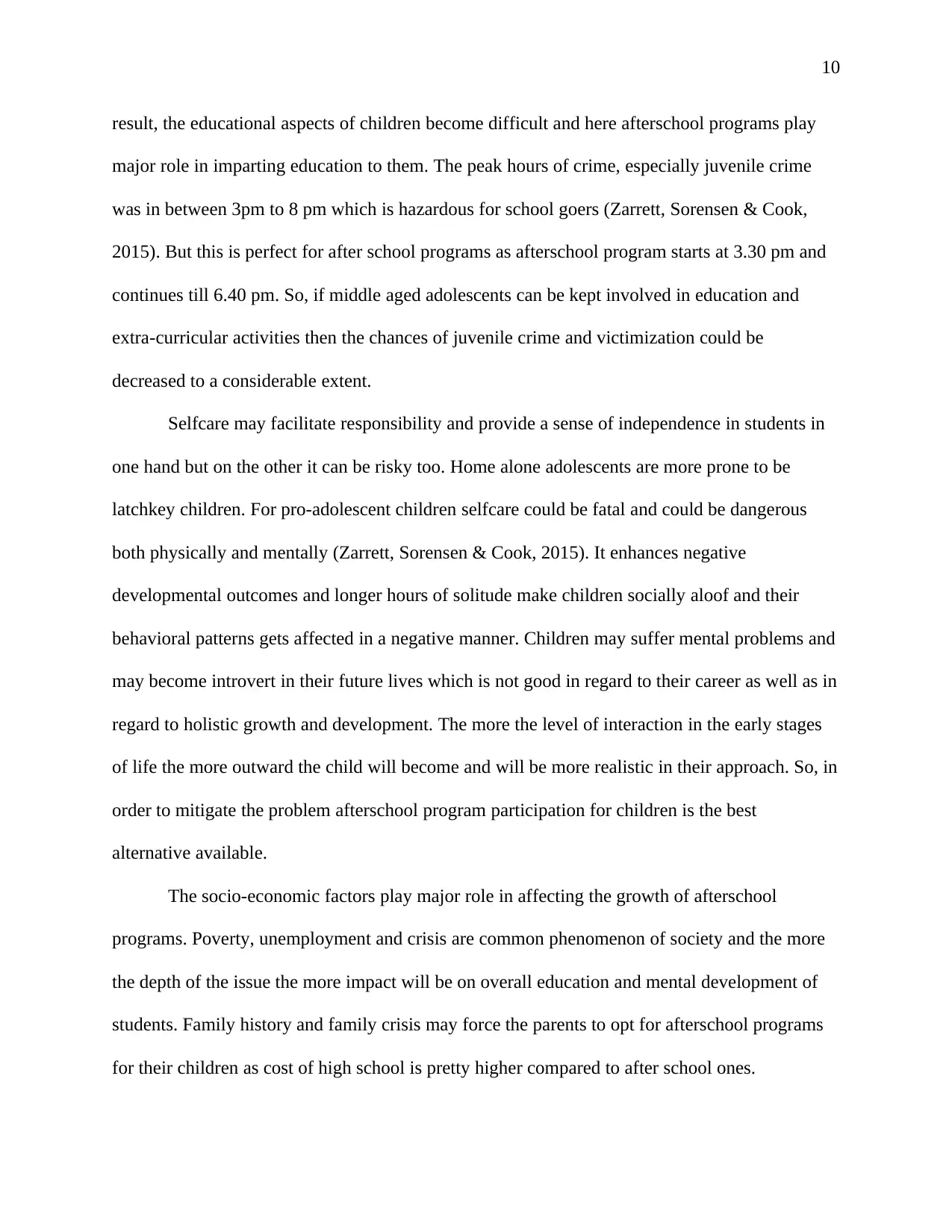
10
result, the educational aspects of children become difficult and here afterschool programs play
major role in imparting education to them. The peak hours of crime, especially juvenile crime
was in between 3pm to 8 pm which is hazardous for school goers (Zarrett, Sorensen & Cook,
2015). But this is perfect for after school programs as afterschool program starts at 3.30 pm and
continues till 6.40 pm. So, if middle aged adolescents can be kept involved in education and
extra-curricular activities then the chances of juvenile crime and victimization could be
decreased to a considerable extent.
Selfcare may facilitate responsibility and provide a sense of independence in students in
one hand but on the other it can be risky too. Home alone adolescents are more prone to be
latchkey children. For pro-adolescent children selfcare could be fatal and could be dangerous
both physically and mentally (Zarrett, Sorensen & Cook, 2015). It enhances negative
developmental outcomes and longer hours of solitude make children socially aloof and their
behavioral patterns gets affected in a negative manner. Children may suffer mental problems and
may become introvert in their future lives which is not good in regard to their career as well as in
regard to holistic growth and development. The more the level of interaction in the early stages
of life the more outward the child will become and will be more realistic in their approach. So, in
order to mitigate the problem afterschool program participation for children is the best
alternative available.
The socio-economic factors play major role in affecting the growth of afterschool
programs. Poverty, unemployment and crisis are common phenomenon of society and the more
the depth of the issue the more impact will be on overall education and mental development of
students. Family history and family crisis may force the parents to opt for afterschool programs
for their children as cost of high school is pretty higher compared to after school ones.
result, the educational aspects of children become difficult and here afterschool programs play
major role in imparting education to them. The peak hours of crime, especially juvenile crime
was in between 3pm to 8 pm which is hazardous for school goers (Zarrett, Sorensen & Cook,
2015). But this is perfect for after school programs as afterschool program starts at 3.30 pm and
continues till 6.40 pm. So, if middle aged adolescents can be kept involved in education and
extra-curricular activities then the chances of juvenile crime and victimization could be
decreased to a considerable extent.
Selfcare may facilitate responsibility and provide a sense of independence in students in
one hand but on the other it can be risky too. Home alone adolescents are more prone to be
latchkey children. For pro-adolescent children selfcare could be fatal and could be dangerous
both physically and mentally (Zarrett, Sorensen & Cook, 2015). It enhances negative
developmental outcomes and longer hours of solitude make children socially aloof and their
behavioral patterns gets affected in a negative manner. Children may suffer mental problems and
may become introvert in their future lives which is not good in regard to their career as well as in
regard to holistic growth and development. The more the level of interaction in the early stages
of life the more outward the child will become and will be more realistic in their approach. So, in
order to mitigate the problem afterschool program participation for children is the best
alternative available.
The socio-economic factors play major role in affecting the growth of afterschool
programs. Poverty, unemployment and crisis are common phenomenon of society and the more
the depth of the issue the more impact will be on overall education and mental development of
students. Family history and family crisis may force the parents to opt for afterschool programs
for their children as cost of high school is pretty higher compared to after school ones.
Paraphrase This Document
Need a fresh take? Get an instant paraphrase of this document with our AI Paraphraser
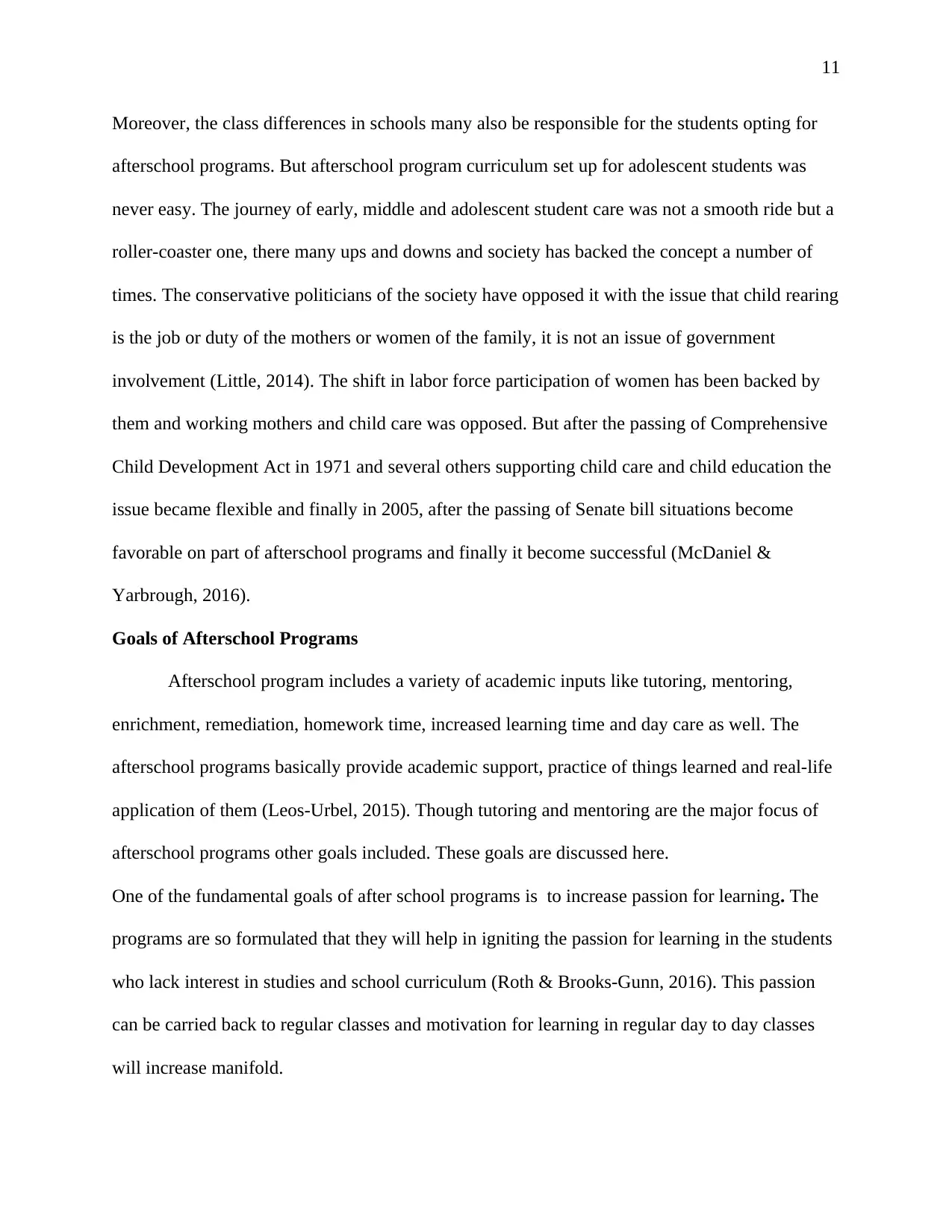
11
Moreover, the class differences in schools many also be responsible for the students opting for
afterschool programs. But afterschool program curriculum set up for adolescent students was
never easy. The journey of early, middle and adolescent student care was not a smooth ride but a
roller-coaster one, there many ups and downs and society has backed the concept a number of
times. The conservative politicians of the society have opposed it with the issue that child rearing
is the job or duty of the mothers or women of the family, it is not an issue of government
involvement (Little, 2014). The shift in labor force participation of women has been backed by
them and working mothers and child care was opposed. But after the passing of Comprehensive
Child Development Act in 1971 and several others supporting child care and child education the
issue became flexible and finally in 2005, after the passing of Senate bill situations become
favorable on part of afterschool programs and finally it become successful (McDaniel &
Yarbrough, 2016).
Goals of Afterschool Programs
Afterschool program includes a variety of academic inputs like tutoring, mentoring,
enrichment, remediation, homework time, increased learning time and day care as well. The
afterschool programs basically provide academic support, practice of things learned and real-life
application of them (Leos-Urbel, 2015). Though tutoring and mentoring are the major focus of
afterschool programs other goals included. These goals are discussed here.
One of the fundamental goals of after school programs is to increase passion for learning. The
programs are so formulated that they will help in igniting the passion for learning in the students
who lack interest in studies and school curriculum (Roth & Brooks-Gunn, 2016). This passion
can be carried back to regular classes and motivation for learning in regular day to day classes
will increase manifold.
Moreover, the class differences in schools many also be responsible for the students opting for
afterschool programs. But afterschool program curriculum set up for adolescent students was
never easy. The journey of early, middle and adolescent student care was not a smooth ride but a
roller-coaster one, there many ups and downs and society has backed the concept a number of
times. The conservative politicians of the society have opposed it with the issue that child rearing
is the job or duty of the mothers or women of the family, it is not an issue of government
involvement (Little, 2014). The shift in labor force participation of women has been backed by
them and working mothers and child care was opposed. But after the passing of Comprehensive
Child Development Act in 1971 and several others supporting child care and child education the
issue became flexible and finally in 2005, after the passing of Senate bill situations become
favorable on part of afterschool programs and finally it become successful (McDaniel &
Yarbrough, 2016).
Goals of Afterschool Programs
Afterschool program includes a variety of academic inputs like tutoring, mentoring,
enrichment, remediation, homework time, increased learning time and day care as well. The
afterschool programs basically provide academic support, practice of things learned and real-life
application of them (Leos-Urbel, 2015). Though tutoring and mentoring are the major focus of
afterschool programs other goals included. These goals are discussed here.
One of the fundamental goals of after school programs is to increase passion for learning. The
programs are so formulated that they will help in igniting the passion for learning in the students
who lack interest in studies and school curriculum (Roth & Brooks-Gunn, 2016). This passion
can be carried back to regular classes and motivation for learning in regular day to day classes
will increase manifold.
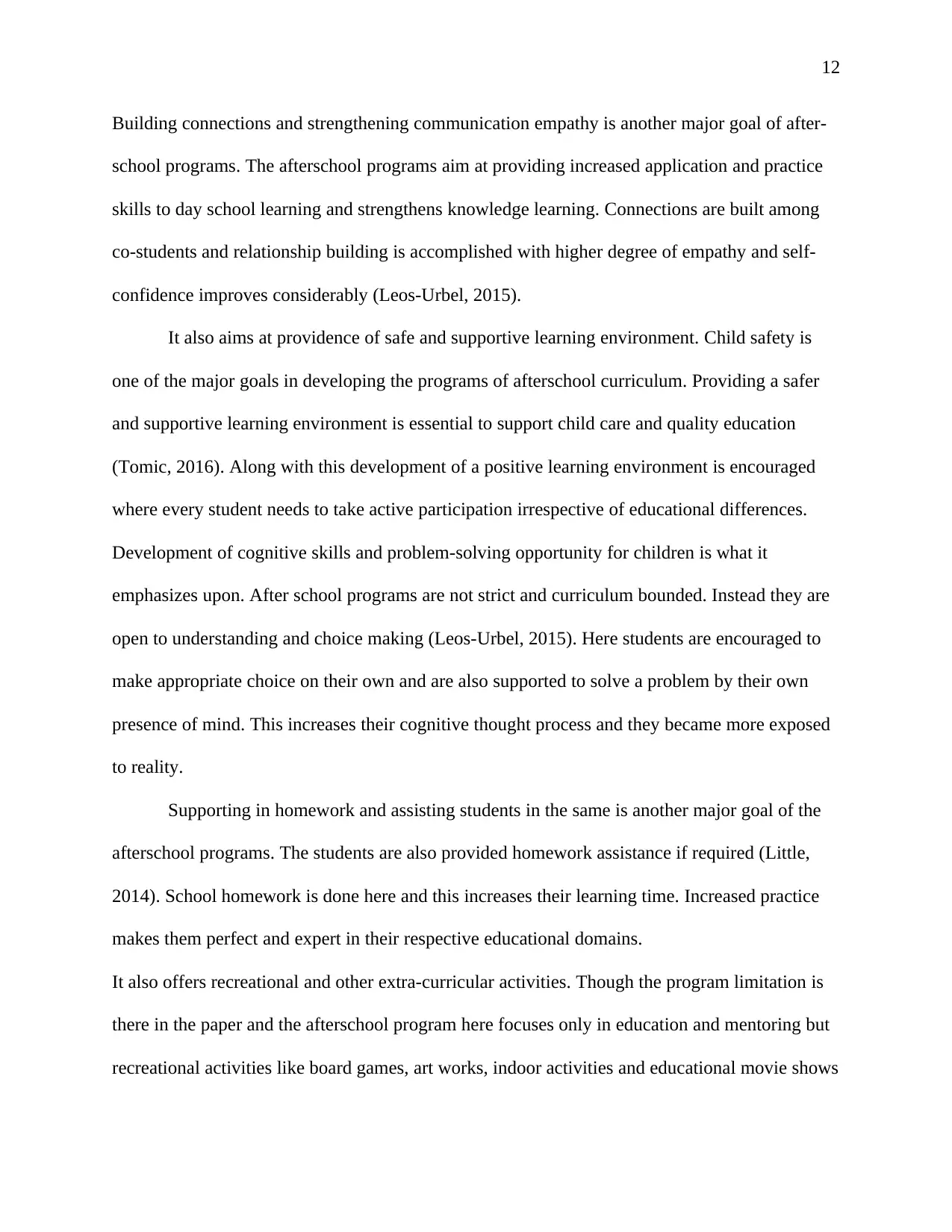
12
Building connections and strengthening communication empathy is another major goal of after-
school programs. The afterschool programs aim at providing increased application and practice
skills to day school learning and strengthens knowledge learning. Connections are built among
co-students and relationship building is accomplished with higher degree of empathy and self-
confidence improves considerably (Leos-Urbel, 2015).
It also aims at providence of safe and supportive learning environment. Child safety is
one of the major goals in developing the programs of afterschool curriculum. Providing a safer
and supportive learning environment is essential to support child care and quality education
(Tomic, 2016). Along with this development of a positive learning environment is encouraged
where every student needs to take active participation irrespective of educational differences.
Development of cognitive skills and problem-solving opportunity for children is what it
emphasizes upon. After school programs are not strict and curriculum bounded. Instead they are
open to understanding and choice making (Leos-Urbel, 2015). Here students are encouraged to
make appropriate choice on their own and are also supported to solve a problem by their own
presence of mind. This increases their cognitive thought process and they became more exposed
to reality.
Supporting in homework and assisting students in the same is another major goal of the
afterschool programs. The students are also provided homework assistance if required (Little,
2014). School homework is done here and this increases their learning time. Increased practice
makes them perfect and expert in their respective educational domains.
It also offers recreational and other extra-curricular activities. Though the program limitation is
there in the paper and the afterschool program here focuses only in education and mentoring but
recreational activities like board games, art works, indoor activities and educational movie shows
Building connections and strengthening communication empathy is another major goal of after-
school programs. The afterschool programs aim at providing increased application and practice
skills to day school learning and strengthens knowledge learning. Connections are built among
co-students and relationship building is accomplished with higher degree of empathy and self-
confidence improves considerably (Leos-Urbel, 2015).
It also aims at providence of safe and supportive learning environment. Child safety is
one of the major goals in developing the programs of afterschool curriculum. Providing a safer
and supportive learning environment is essential to support child care and quality education
(Tomic, 2016). Along with this development of a positive learning environment is encouraged
where every student needs to take active participation irrespective of educational differences.
Development of cognitive skills and problem-solving opportunity for children is what it
emphasizes upon. After school programs are not strict and curriculum bounded. Instead they are
open to understanding and choice making (Leos-Urbel, 2015). Here students are encouraged to
make appropriate choice on their own and are also supported to solve a problem by their own
presence of mind. This increases their cognitive thought process and they became more exposed
to reality.
Supporting in homework and assisting students in the same is another major goal of the
afterschool programs. The students are also provided homework assistance if required (Little,
2014). School homework is done here and this increases their learning time. Increased practice
makes them perfect and expert in their respective educational domains.
It also offers recreational and other extra-curricular activities. Though the program limitation is
there in the paper and the afterschool program here focuses only in education and mentoring but
recreational activities like board games, art works, indoor activities and educational movie shows
⊘ This is a preview!⊘
Do you want full access?
Subscribe today to unlock all pages.

Trusted by 1+ million students worldwide
1 out of 47
Related Documents
Your All-in-One AI-Powered Toolkit for Academic Success.
+13062052269
info@desklib.com
Available 24*7 on WhatsApp / Email
![[object Object]](/_next/static/media/star-bottom.7253800d.svg)
Unlock your academic potential
Copyright © 2020–2025 A2Z Services. All Rights Reserved. Developed and managed by ZUCOL.





